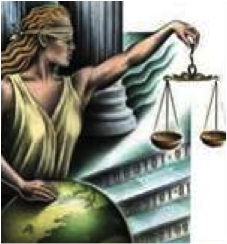
Is justice color blind? Over two million people are held in federal and state prisons and jails in the United States. According to a newly released U.S. Census Report, 67% of the people incarcerated in the U.S. are people of color—41% of whom are African American. As of April 2010, 51.5% of prisoners in federal prisons are incarcerated for drug related offenses, and about 20% of state prisoners are jailed for drug offenses.
A challenge in Black and White. . .
- An African American man is 11.8 times more likely to go to prison for a drug offense than a white man is for the same offense.
- A U.S. African American woman is 4.8 times more likely to be sentenced to prison for a drug offense than a white woman is for the same offense.
- The Anti-Drug Abuse Act of 1986—widely known as the 100:1 act—constituted an inequality that existed for more than a generation.
- This law mandated vastly different punishments for crack cocaine vs. powder cocaine.
- The possession of only one gram of crack cocaine led to a mandatory prison sentence, while the law required 100 grams of powder cocaine to lead to a prison sentence.
- It’s also important to note that 66% of U.S. crack cocaine users are White or Hispanic, but Whites and Hispanics are only 7.8% of those sent to prison for crack cocaine use.
- Black Americans, on the other hand—who make up a minority of the crack users—are 80% of the prison population incarcerated for crack cocaine use.
A change…
- In 2010, President Obama signed into law the “Fair Sentencing Act” that reduces the ratio from 100:1 to 18:1 for possession and use of crack cocaine and strengthens penalties for more dangerous and violent drug traffickers.
- The bill shrinks but does not close the gap.
- US Attorney General Eric Holder is asking that we “retroactively bring the sentences for crack cocaine in line with those of powder cocaine.”
- To ensure equal treatment under the law, Holder argues, it is “necessary to apply the new sentences retroactively to prisoners currentlyserving time for crack cocaine offenses.”
Sources: “Cocaine and Crack by Demographics, Office of Applied Studies,” Department of Health and Human Services, 2003. “Creative Destruction —Crack Cocaine Sentencing: Systematic Racism at Work,” World Press, http://creativedestruction.wordpress.com, 6/22/11. Deborah J. Vagins, & Jesselyn McCurdy, “Cracks in The System: Twenty Years of Unjust Federal Crack Cocaine Law,” American Civil Liberty Union, 10/06. John McWhorter, "How The War on Drugs Is Destroying Black America," Cato'sLetter, The Cato Institute, http://www.cato.org/pubs, 2011.“Persons Arrested by Offense, Sex, and Race: 2008.” U.S. Census Bureau, http://www.census.gov/compendia, 6/22/11. Zach Zagger “Holder Calls for Retroactive Application of Reduced Crack Sentencing Law,” JURIST: Legal News & Research, http://jurist.org, 6/1/11. “President Obama Signs Bill Reducing Cocaine Sentencing Disparity,” American Civil Liberties Union, http://www.aclu.org/drug-law-reform, 8/3/11
This factsheet was written by Ginny Downie of Fredericksburg for her website www.justthoughtyoushouldknow.org


